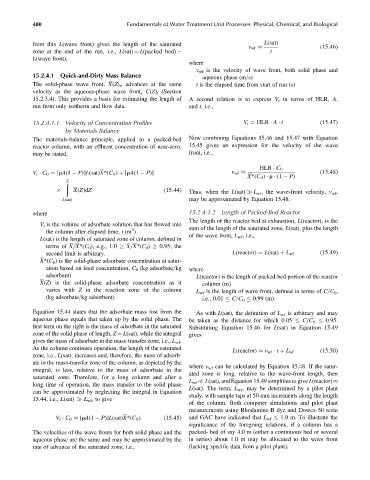Page 525 - Fundamentals of Water Treatment Unit Processes : Physical, Chemical, and Biological
P. 525
480 Fundamentals of Water Treatment Unit Processes: Physical, Chemical, and Biological
from this L(wave front) gives the length of the saturated L(sat)
t
v wf (15:46)
zone at the end of the run, i.e., L(sat) ¼ L(packed bed)
L(wave front).
where
v wf is the velocity of wave front, both solid phase and
15.2.4.1 Quick-and-Dirty Mass Balance aqueous phase (m=s)
The solid-phase wave front, X(Z) t , advances at the same t is the elapsed time from start of run (s)
velocity as the aqueous-phase wave front, C(Z) t (Section
15.2.3.4). This provides a basis for estimating the length of A second relation is to express V t in terms of HLR, A,
run from only isotherm and flow data. and t, i.e.,
15.2.4.1.1 Velocity of Concentration Profiles V t ¼ HLR A t (15:47)
by Materials Balance
The materials-balance principle, applied to a packed-bed Now combining Equations 15.46 and 15.47 with Equation
reactor column, with an effluent concentration of near-zero, 15.45 gives an expression for the velocity of the wave
may be stated, front, i.e.,
HLR C 0
V t C 0 ¼ [rA(1 P)]L(sat)X*(C 0 ) þ [rA(1 P)] v wf (15:48)
X*(C 0 ) r (1 P)
ð Z
X(Z)dZ (15:44)
Thus, when the L(sat) L wf , the wave-front velocity, v wf ,
L(sat) may be approximated by Equation 15.48.
where 15.2.4.1.2 Length of Packed-Bed Reactor
The length of the reactor bed at exhaustion, L(reactor), is the
V t is the volume of adsorbate solution that has flowed into sum of the length of the saturated zone, L(sat), plus the length
3
the column after elapsed time, t (m )
of the wave front, L wf , i.e.,
L(sat) is the length of saturated zone of column, defined in
terms of X=X*(C 0 ), e.g., 1.0 X=X*(C 0 ) 0.95; the
second limit is arbitrary. L(reactor) ¼ L(sat) þ L wf (15:49)
X*(C 0 ) is the solid-phase adsorbate concentration at satur-
ation based on feed concentration, C 0 (kg adsorbate=kg where
adsorbent) L(reactor) is the length of packed-bed portion of the reactor
X(Z) is the solid-phase adsorbate concentration as it column (m)
varies with Z in the reaction zone of the column L wf is the length of wave front, defined in terms of C=C 0 ,
(kg adsorbate=kg adsorbent) i.e., 0.01 C=C 0 0.99 (m)
Equation 15.44 states that the adsorbate mass lost from the As with L(sat), the definition of L wf is arbitrary and may
aqueous phase equals that taken up by the solid phase. The be taken as the distance for which 0.05 C=C 0 0.95.
first term on the right is the mass of adsorbate in the saturated Substituting Equation 15.46 for L(sat) in Equation 15.49
zone of the solid phase of length, Z ¼ L(sat), while the integral gives
gives the mass of adsorbate in the mass-transfer zone, i.e., L wf .
As the column continues operation, the length of the saturated
L(reactor) v wf t þ L wf (15:50)
zone, i.e., L(sat), increases and, therefore, the mass of adsorb-
ate in the mass-transfer zone of the column, as depicted by the
where v wf can be calculated by Equation 15.48. If the satur-
integral, is less, relative to the mass of adsorbate in the
ated zone is long, relative to the wave-front length, then
saturated zone. Therefore, for a long column and after a
long time of operation, the mass transfer to the solid phase L wf L(sat), and Equation 15.49 simplifies to give L(reactor)
L(sat). The term, L wf , may be determined by a pilot plant
can be approximated by neglecting the integral in Equation
study, with sample taps at 50 mm increments along the length
15.44, i.e., L(sat) L wf , to give
of the column. Both computer simulations and pilot plant
measurements using Rhodamine-B dye and Dowex-50 resin
V t C 0 [rA(1 P)]L(sat)X*(C 0 ) (15:45) and GAC have indicated that L wf 1.0 m. To illustrate the
significance of the foregoing relations, if a column has a
The velocities of the wave fronts for both solid phase and the packed- bed of say 4.0 m (either a continuous bed or several
aqueous phase are the same and may be approximated by the in series) about 1.0 m may be allocated to the wave front
rate of advance of the saturated zone, i.e., (lacking specific data from a pilot plant).

